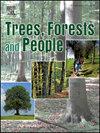Validated allometric models for volume, biomass, carbon, and nutrient estimation in forest ecosystems of Bangladesh: A step toward sustainable forest management and climate resilience
IF 2.7
Q1 FORESTRY
引用次数: 0
Abstract
Accurate volume and biomass estimation of tree resources of forest ecosystems are essential for sustainable forest management, carbon stock assessments, and climate change mitigation. This study aimed to develop a complete database of the available volume, biomass, and carbon allometric equations for the different plant life forms of Bangladesh. It also wanted to generate a validated database of allometric equations. This study used a systematic literature review process to ensure comprehensive, accurate, and relevant data collection. This study presents a comprehensive unvalidated database of 1,015 allometric volume and biomass models developed for trees, shrubs, palms, and bamboo across diverse forest types (natural, plantations, and trees outside forests). All these available equations were validated through a four-step quality control process. Finally, 349 allometric equations passed the validation processes. A total of 325 species-specific validated equations were recorded for 62 species, and 24 equations for group and stand level. Trees are the primary contributors followed by shrubs, while palms and bamboo have no representation in the validated equations. The findings highlight the critical need for species- and site-specific models, as reliance on pantropical models may introduce inaccuracies. This validated database supports accurate biomass and carbon stock estimations, strengthens national climate reporting frameworks such as REDD+, and enhances Monitoring, Reporting, and Verification (MRV) systems. The study highlights the importance of ongoing research and integrating emerging technologies to refine and expand allometric models for better forest management and climate change mitigation in Bangladesh.
孟加拉国森林生态系统体积、生物量、碳和养分估算的有效异速生长模型:迈向可持续森林管理和气候适应能力的一步
森林生态系统树木资源的准确体积和生物量估算对于可持续森林管理、碳储量评估和减缓气候变化至关重要。本研究旨在建立一个完整的数据库,包括孟加拉国不同植物生命形式的可用体积、生物量和碳异速生长方程。它还希望生成一个有效的异速生长方程数据库。本研究采用了系统的文献综述过程,以确保数据收集的全面、准确和相关。本研究提出了一个综合的未经验证的数据库,其中包含1015个异速体积和生物量模型,这些模型是针对不同森林类型(天然林、人工林和森林外树木)的乔木、灌木、棕榈和竹子开发的。所有可用的方程都通过四步质量控制过程进行验证。最后,349个异速生长方程通过了验证过程。共记录了62种的325个物种特异性验证方程,24个群落和林分水平验证方程。树木是主要贡献者,其次是灌木,而棕榈树和竹子在验证方程中没有表示。这些发现强调了对物种和地点特定模型的迫切需要,因为依赖泛热带模型可能会引入不准确性。这个经过验证的数据库支持准确的生物量和碳储量估算,加强了REDD+等国家气候报告框架,并加强了监测、报告和核查(MRV)系统。该研究强调了正在进行的研究和整合新兴技术对改进和扩展异速生长模型的重要性,有助于孟加拉国更好地管理森林和减缓气候变化。
本文章由计算机程序翻译,如有差异,请以英文原文为准。
求助全文
约1分钟内获得全文
求助全文
来源期刊

Trees, Forests and People
Economics, Econometrics and Finance-Economics, Econometrics and Finance (miscellaneous)
CiteScore
4.30
自引率
7.40%
发文量
172
审稿时长
56 days
 求助内容:
求助内容: 应助结果提醒方式:
应助结果提醒方式:


